

After the upheavals of the Tower (XVI) and before the revelation of the Sun (XVIIII). Like a necessary passage between the collapse of illusions and spiritual enlightenment, the Moon invites the querent to travel through the darkness of the unconscious.
Medieval astrologers shaped our view of the Moon as a symbol of changeability. This reputation comes from its visibly changing appearance during its monthly cycles and its quick movement across the night sky. The first celestial body visible to the naked eye after the Sun because of its brightness and closeness, the Moon has fascinated all civilizations with its cyclical and mysterious nature.
As the ruler of the night, the Moon reigns over a realm very different from that of the Sun: not the world of clear light and waking consciousness, but the world of moving shadows, mysteries, and hidden dangers. It is exactly this nighttime dimension that gives the card its special aura of ambivalence and mystery.
The Nebra Sky Disk: first lunar mapping
Discovered in Germany and dated to around 1600 BC, the Nebra Disk is one of the oldest concrete representations of the cosmos. This remarkable bronze artifact, decorated with gold inlays, shows a clearly identifiable crescent moon, a full circle (interpreted as the full moon or the sun), and several stars, including a group that looks like the Pleiades. Archaeologists now agree it is much more than a simple illustration: it was a real astronomical instrument used to harmonize the lunar and solar calendars.
This function of cosmic harmonization is especially meaningful. It shows that as early as the Bronze Age, European peoples saw the Moon as an essential part of measuring and organizing time. The Nebra Disk shows a sophisticated understanding of lunar cycles, allowing people to know the best times for planting and harvesting, making a direct link between the night star and the rhythms of life on earth.
Selene: divine personification in ancient Greece
In Greek mythology, Selene is the divine personification of the Moon. Daughter of the Titans Hyperion and Theia, sister of Helios (the Sun) and Eos (the Dawn), she holds an important place in the Greek pantheon, although she is later associated or sometimes confused with other lunar goddesses like Artemis or Hecate.
Traditional images show Selene wearing a crescent moon on her head or forehead, dressed in flowing robes and driving a silver chariot pulled by two white horses (sometimes replaced by oxen) across the night sky. This image of the night sky journey deeply influenced the way the Moon is shown in the tarot, where this idea of crossing and passage is often present.
On the east pediment of the Parthenon in Athens, Selene is shown going down into the ocean with her horses, marking the end of the night as, at the other end, Helios rises from the waves to begin his daytime journey. This cyclical image perfectly shows the Greek idea of time as an endless succession of opposite but complementary phases.
The most famous myth about Selene tells of her love for the handsome shepherd Endymion. In love with this mortal, the goddess asked Zeus to give him eternal sleep, keeping his youth and beauty. Every night, she came down from the sky to visit her beloved, sleeping in a cave on Mount Latmos. This love story between a heavenly goddess and a mortal in a state between life and death foretells the psychological meaning of the Moon in tarot – this state between consciousness and unconsciousness, between material and spiritual.
In Greek mystery cults, especially those linked to Hecate and the Eleusinian mysteries, the Moon was also connected to ideas of initiation and inner transformation.
With the arrival of Christianity in Europe, lunar symbolism changed in important ways. Instead of being rejected, it was included in Christian images through subtle but powerful connections, especially with the figure of the Virgin Mary.
The best-known example of this is the image of Mary standing on a crescent moon, often linked to the theme of the Immaculate Conception. This picture comes directly from a passage in the Apocalypse of Saint John (12:1) describing "a woman clothed with the sun, with the moon under her feet and a crown of twelve stars on her head." In this vision, the moon under Mary's feet shows her power over the changing and imperfect world of matter.
This special position of the crescent moon is symbolically important: it shows the victory of Mary's purity over the changeability and uncertainty given to the moon. While the night star was usually linked to cycles, changes, and sometimes occult forces, Mary, in her immaculate conception and her nature free from original sin, goes beyond this changing nature.
Medieval bestiaries, those collections of real or fantastic animals explained from a Christian point of view, often connect the moon to special creatures like the owl (symbol of night wisdom but also heresy), the unicorn (purity), or the wolf (danger). This link between the moon and special animals comes before the animals we later see on the tarot card: dogs, wolves, crayfish, or hybrid creatures.
In traditional astrology, each celestial body has elemental qualities that determine its influence. The Moon was classically described as cold and moist in nature. This description was not just poetic, but was part of a real theory about cosmic influences on the sublunar world (the world below the Moon's sphere).
The Moon's ability to pull on objects with its gravitational attraction was already recognized long before Newton's scientific explanation. The tides, a visible sign of this pull, led astrologers to say the Moon had power over everything that is fluid—not just the water in oceans, but also body fluids, changing emotions, and even the movement of moods in the human body according to the medicine of the time.
The Moon as a cosmic go-between
In medieval cosmology, the Moon held a special place. As the planetary sphere closest to Earth, it stood as the border between the heavenly world (perfect and unchanging) and the earthly world (changing and corruptible). This in-between position gave it a crucial role: it received energy from the Sun and the five classic planets (Mercury, Venus, Mars, Jupiter, and Saturn), then allowed this energy to take material form on Earth.
The Moon and the world of mental images
A very interesting part of the astrological idea of the Moon is its link to the world of mental images. In the astrological tradition, the Moon was seen as "the place where mental images are stored, which finally give birth to visions and dreams". This idea was amazingly close to our modern view of the unconscious and imagination.
The animals on the card—whether howling dogs or wolves, or the crayfish (or crab) coming out of the water—stand for primitive psychic content that rises to the surface of our awareness in this state between waking and sleeping ruled by the Moon. These creatures show our instincts, old fears, and non-rational perceptions that come up when the direct light of solar reason fades.
Cancer and its symbolic influence
In astrology, the Moon rules the sign of Cancer, shown by the crab. This link is important for understanding the card's symbolism. The Cancer crab, with its protective shell and its ability to move in any direction (sometimes sideways or backwards), became in astrology a symbol of indecision and mental confusion. This trait is seen directly in the divinatory meaning of the card, often linked to times of uncertainty and non-linear paths.
Deception and illusion: the Moon that distorts reality
"Deception" is one of the oldest meanings linked to the Moon card. This comes from a simple but deep observation: moonlight, unlike sunlight, changes how we see things. Traveling under the light of the moon can feel unsettling—noises come from dark shadows, and familiar shapes like trees or the land can look like monster creatures.
This special quality of moonlight, which reveals without really lighting up, led to the idea of the "lying moon" in the traditions of Mediterranean sailors. These sailors were afraid that the moon's reflections on the water could hide dangerous reefs or create tricky optical illusions.
Madness and lack of reason: the mind under the Moon's influence
The word "lunatic" that we still use today did not appear by chance. Since ancient times, people believed the Moon, especially the full moon, could disturb mental balance. This belief was so common that even Hippocrates, father of Western medicine, wrote that "those seized by madness are troubled mainly at night, especially when the moon shines."
In European folk traditions of the Middle Ages, people often spoke of the "mad moon"—the one that pushed people to irrational behavior. This influence was seen as very dangerous for lone travelers who might fall into hallucinations or self-destructive urges. This belief was so deep in the culture that Shakespeare himself mentions it in his play "Othello," where he writes: "It is the moon that makes men mad; she comes nearer the earth than she was wont, and makes men mad."
Monstrous transformation: the moon and metamorphosis
The link between the full moon and turning into a werewolf is one of the most famous superstitions about the night star. This belief in lycanthropy—transformation of a man into a wild beast under the full moon's power—shows a deep fear: that our civilized nature could fall back into something animal, uncontrollable, and dangerous.
In many places in central Europe, people thought that children born on full moon nights might develop animal traits or become shapeshifters. To protect these newborns, midwives had to do special rituals to stop this bad influence.
The realm of the dead: the Moon as guide of souls
In many cultures around the world, the Moon is linked to the land of the dead and wandering souls. In ancient Greece, the goddess Hecate, linked to the moon in her dark phase, ruled crossroads and practices of necromancy. In Chinese traditions, the lunar world was sometimes seen as a stage in the journey of souls after death.
Japanese folklore is especially rich in stories of yūrei—ghosts or spirits—who appear in moonlight, especially during the O-Bon period when the line between the world of the living and the dead becomes thin. Japanese Buddhist tradition also links the moon to impermanence and death, reminding us that everything that shines will one day fade away.
Dangerous femininity: the other face of the Moon
While the Moon often stands for the feminine principle in its nurturing and motherly side, she also represents, in many patriarchal traditions, her most feared aspects. The "lunar woman" showed unpredictability, irrationality, and a mysterious power seen as possibly dangerous.
During the great witch hunts in Europe (15th-17th centuries), women accused of witchcraft were often thought to get their power from lunar rituals. The full moon was supposed to be the favorite time for their sabbaths and occult ceremonies. Later, in the 19th century, the phrase "woman under the influence of the moon" became almost a medical term for different kinds of female emotional instability, sometimes used to justify forced treatments or confinement.
This double view of feminine power is seen in the Moon card, which can mean both gifts of intuition and deep vision, and the traps of illusion and emotional confusion.
Cycle and fading: the waning Moon
The lunar cycle, with its regular phases of growing and shrinking, always reminds us that every high point is followed by a decline. The waning or "black" moon stood for fading, sickness, and the slow loss of vital energy in many traditions.
Traditional farmers especially feared the bad effects of the "black moon" on their crops, and many practices were done to guard against its negative influence. This time in the cycle was linked to emptiness, exhaustion, and was seen as a very vulnerable period.
The reflection as a deceiving double
In symbolic tradition, the reflection of the moon on water is often seen as a reversed and possibly tricky image of reality. This watery double suggests the depths of our unconscious where our hidden wishes and deepest fears lie.
Several Asian tales warn against staring too long at the moon's reflection in water, because this could pull the viewer's soul, trapping it between two worlds.This warning shows the risk of getting lost in illusions or in too much self-reflection, cut off from real life.
Light in the darkness: the protective Moon in the West
In Western traditions, the Moon has long stood for a feminine principle that is kind and protective. Linked to the goddesses Artemis among the Greeks and Diana among the Romans, she shows purity, protection, and feminine sovereignty. These lunar goddesses especially watched over women, children, and wild animals—all seen as vulnerable and needing protection.
Far from being seen only as a scary star, the Moon was also considered a valuable guide for travelers lost at night. Her light, even if not full, helped people find their way in the darkness.
The Moon’s cyclical nature closely connects her to fertility rhythms. Her 28-day cycle is almost the same as the female menstrual cycle, making her a strong symbol of creative feminine power, motherhood, and never-ending renewal. Traditional farming societies in Europe celebrated full moons as special times for good harvests and prosperity. These celebrations, some of which survived in rural folklore until the 20th century, included dances, songs, and rituals to honor the moonlight as a source of life and abundance.
Wisdom and celebration: the Moon in Middle Eastern cultures
In Middle Eastern civilizations, the Moon is at the center of both social and religious life. The Muslim lunar calendar sets the rhythm of important holidays and celebrations, especially the holy month of Ramadan, which starts with the first crescent moon after the new moon. This connection to time makes the Moon not a distant and cold star, but a faithful companion that gently organizes human time and spiritual practices.
The rich Persian and Arabic poetic tradition is full of lunar metaphors to describe ideal beauty. The face of the beloved is often compared to the full moon (badr) in countless love poems like ghazals and qasidas. This link between perfect feminine beauty and the moon is more than just a physical comparison; it suggests an inner light, a beauty that guides and inspires, just as the moon guides the night traveler crossing the desert.
In the traditional nomadic societies of desert regions, the moon was also a friendly symbol of hospitality and generosity. Its light made night journeys possible during the hottest times of the year and offered travelers a constant, reliable guide in the vast, sometimes confusing desert. Caravans often planned their routes according to the moon’s phases, making this star a precious ally for survival and trade.
Harmony and gathering: lunar celebrations in Asia
Asia perhaps offers the happiest and most community-based celebrations in honor of the Moon. In China, the Mid-Autumn Festival (also called the Moon Festival) is one of the most important in the traditional calendar. Families come together to share “moon cakes” (yuèbing) while gazing at the full, round moon, a symbol of family unity and wholeness. This centuries-old tradition turns the night star into a powerful symbol of reunion and social harmony, especially important in a culture that deeply values family bonds.
In traditional Chinese cosmology, the Moon represents the Yin principle, complementing the solar Yang. Unlike some Western ideas that see this duality as opposed or in conflict, Chinese thought sees it as the very foundation of cosmic balance and universal harmony. The Moon brings coolness, rest, and renewal in a perfect cycle with the Sun’s active and dynamic energy. Chang’e, the Chinese moon goddess, symbol of beauty, grace, and immortality, is imagined living in a beautiful jade palace on the moon, often with a rabbit making the elixir of immortality.
In Japan, the practice of tsukimi (literally “moon viewing”) is a very refined aesthetic tradition. People gather to admire the short-lived beauty of the autumn moon, seen as the most beautiful of the year, while thinking about the fleeting nature of all things. This practice fits the aesthetic idea of “mono no aware”—the gentle sadness felt before the passing beauty of the world. But instead of sadness, this contemplation inspires a deep appreciation of the present moment, made richer by knowing it will not last.
In Indian Hindu tradition, the moon god Chandra is linked to fertility, plant growth, and spiritual blooming. Many rituals connected to the lunar phases are meant to bring prosperity and fertility into homes. The moon is also closely tied to the god Soma, who is both the sacred drink of immortality and its divine person, making a direct connection between the night star and very positive ideas of eternal life and spiritual happiness.
The Moon and universal romance
The link between the Moon and love seems to go beyond cultural borders, appearing as an almost universal archetype. Moonlit walks are seen everywhere as romantic, naturally creating a special mood for closeness and sharing that helps people open up. The special quality of moonlight, soft and mysterious, changes the ordinary world into an enchanting place that encourages secrets and the sharing of deep feelings.
In Chinese tradition, there is a touching belief: lovers separated by distance can find comfort knowing they are looking at the same moon, even if they are thousands of kilometers apart. This “reunion moon” gives an emotional connection even in the most painful separation. Poems from the Tang dynasty, especially those by Li Bai, often explore this theme of the moon as an invisible but strong bridge between hearts separated by circumstance.
Japanese literature often uses the image of the moon reflected on water as a very subtle metaphor for love—both hard to catch but deeply present, at once reflection and reality. Traditional haikus celebrate these special moments when sharing the beauty of the moon makes love feel eternal, even inside the short experience of life.
In the splendid Visconti-Sforza deck, created around 1450 for the powerful Milanese family of the same name, the Moon has a totally different look from what we know today. She represents Diana, the Roman goddess of hunting and the moon. This divine figure appears elegant and majestic, dressed in a medieval gown typical of Italian Renaissance Quattrocento, very different from the more cosmic images used in later tarot decks.
Diana was honored as the protector of women giving birth and wild animals, while also being linked to hunting. On this card, she seems to hold what could be a relaxed bow or, more likely, a white belt tied to her dress. This detail is important because the white belt was a traditional symbol of chastity, a quality strongly linked to this goddess who, according to myth, vowed to stay a virgin forever.
This first image shows the humanist and classical approach of the Italian Renaissance, which drew a lot from Greco-Roman mythology to create visual allegories. The card shows the big influence of noble Italian families like the Visconti and Sforza, who supported the arts and wanted works that glorified their social status with famous mythological references.
The so-called "Budapest" tarot, less known but historically important, shows a completely unique interpretation of the Moon. Dating from around the end of the 15th century, this card shows a man who seems to bend under the weight of a moon he carries on his shoulders.
This image immediately brings to mind the myth of Atlas, condemned by Zeus to carry the sky forever after the Titans lost. However, this is not Atlas carrying the globe of the earth as is often shown, but a man specifically holding the weight of the moon.
This symbolism could be seen as a picture of the psychological burdens linked to the Moon—the fears of the night, the unconscious, emotions, and dreams that sometimes weigh heavily on the human soul. At a time when astrology saw lunar influences as possibly disturbing for mental balance, this image visually showed the idea that people sometimes have to carry the weight of lunar forces that affect their destiny.
The Budapest tarot shows a path of images that did not last, but it proves the diversity of symbolic ideas explored during this early period of European tarot, before some models became the standard.
The oldest and most lasting image of the Moon in the first tarots shows astrologers or astronomers (these two fields were not clearly separated at the time) busy observing. These cards reflect the big importance of astronomy and astrology in 15th and 16th century Europe, where these sciences guided both political and medical decisions.
In the Este tarot (around 1450), made for the Este family of Ferrara, as in the so-called "Charles VI" tarot, we see scholars using astronomical measuring tools while looking at what seems to be a lunar eclipse. These tools could be astrolabes or quadrants, which were essential for medieval and Renaissance astronomers to measure the position of celestial bodies.
The Tarocchino Bolognese Al Mondo, a Bologna version that appeared around 1500, keeps this tradition going with remarkable consistency. Its Moon card shows a scholar bent over a study desk, surrounded by astronomical instruments. This image stayed almost unchanged for centuries in the Bologna tradition, showing how important this scientific view of the moon was.
This "learned" view of the Moon showed the intellectual interests of the time, when Italian courts competed to attract the best astronomers and astrologers. These people had a lot of prestige and advised the powerful on the right time for big decisions, battles, or even diplomatic marriages. These cards celebrate the rational observation of the sky instead of the mysterious or scary sides that would later appear in Moon cards.
The Paris Tarot offers a romantic and gallant interpretation of the Moon card that is very different from earlier Italian versions. This card shows a man playing the harp to serenade a naked woman standing on a balcony under the moonlight.
This image fits perfectly with the French style of the time, strongly influenced by chivalric traditions and courtly love. Here the moon is no longer a scientific object of study as in the earlier Italian tarots, but the perfect romantic background, witness to love declarations and secret meetings.
The woman’s nudity on the balcony might be a reference to mythology where Diana (the moon goddess) was seen bathing by the hunter Actaeon—but here turned into a love scene rather than a tragic myth. Her nudity could also mean the vulnerability and honesty of feelings shown by moonlight, far from the social rules of the day.
This card shows the changes in values and interests of the French aristocracy, for whom love affairs and gallantry were central to court life. It also shows how tarot, traveling from Italy to France, adapted to local cultures and the interests of new social classes who used it.
This Paris version is a separate branch in the Moon’s iconography, which would not be used in the later standardization of the Tarot de Marseille, but it shows the richness of regional interpretations before the tarot images were made standard.
The personified Moon: the face in the star
The Moon shows for the first time the star with a clearly drawn human face. This personification of the Moon is not random: it follows a long tradition of celestial anthropomorphism going back to medieval calendars and alchemical illuminations. By giving a face to the Moon, the French master craftsman turned it from a simple astronomical object into a conscious being that watches and influences the earthly world. This image creates a living relationship between the star and the creatures under its influence.
The choice to show the Moon facing forward (and not in profile like in some later tarots) lets it look directly at the scene below, as if the star is watching—or maybe directing—the drama happening under its light. This front view makes us feel there is a watchful presence ruling over nighttime events.
The rays coming down: celestial influence
A special detail is the drops or lines coming from the Moon to the earth. While modern writers often say these are drops of lunar dew, they are really rays or arrows showing the direct influence of the Moon on the earth.
Unlike some interpretations, these rays do not go up from the earth to the Moon but come down from the star to the earth, showing the old idea that celestial bodies send out influences that directly affect living beings. This fits perfectly with the cosmological view of the time, when astrology said that the stars literally "shined out" their influences toward the earth.
The dual wolves: polarity and instinct
What some see as dogs are really wolves howling at the Moon, as their posture shows. An important detail often missed: these wolves are two different colors—one light, one dark. This color duality is not by accident; it probably shows a principle of polarity (male and female), echoing the next Sun card in the Noblet deck, where a man and a woman appear.
Wolves, the ultimate night animals, stand for the instinctive and wild side of the human mind that wakes up under the Moon’s influence. Their howling to the star suggests a basic communication with the forces of the unconscious. These animals seem hypnotized or "called" by the Moon, showing the old belief that the night star has a special pull on instinctive and wild behaviors.
The twin towers: threshold and passage
The two crenellated towers framing the scene are a totally new element. With their battlements and arrow slits, they look like medieval defensive buildings. Their symbolic meaning is complex and has led to many interpretations.
On one hand, these towers can show the guardians of a passage between two worlds—the world of waking awareness and the world of dreams or the unconscious. On the other hand, they might mark out a sacred or magical space, a lunar domain where normal rules no longer apply.
The emerging crayfish: transformation and renewal
In the front of the card, partly in a lake or pond, there is a crayfish (sometimes called a crab, the zodiac sign ruled by the Moon). While some writers connect this animal to indecision or mental confusion because of its sideways walk, I see it differently:
The crayfish is above all an animal that molts, changing its shell to grow. This makes it a strong symbol of transformation and renewal—a theme that fits perfectly with the Moon’s place in the "Fool’s Journey" after the destruction of the ego (XVI - TOWER). The crayfish coming from the water shows the process of psychic renewal that happens after a crisis or collapse.
The three rocks: the fragmented psyche
A very meaningful detail in the Noblet card, often simplified or removed in later versions, is the three separate rocks by the water. Later Marseille tarots usually show just a plain shore, but Noblet seems to have drawn three rocks on purpose.
They might stand for the trinity of the human mind—what modern psychology would call different mental aspects or archetypes. These three, clearly apart from each other, suggest a fragmentation or lack of connection between parts of the psyche—unlike what we see in the Judgment card, where human figures are connected and united.
The double lunar nature
The most striking thing about Madenié’s Moon is its showing both the crescent and the full moon at the same time. Unlike some modern ideas that see this as a solar eclipse, it is really an attempt to show the double nature of the Moon in one picture. This visual duality expresses the changing nature of the Moon and its ability to transform while always staying the same. The profile view shows the crescent shape while keeping the human face that personifies the star.
The night spinner
On these versions of the card, we see a woman sitting and spinning wool or flax with a spinning wheel or spindle. This night work, by the light of the moon above, has been given several meanings.
One reading links this spinner to Clotho, one of the three Moirai (or Fates in Roman mythology), the goddesses who in Greek myth controlled the fate of mortals. Clotho was especially in charge of spinning the thread of each human life. This meaning gives the card a deep connection to destiny and the time that passes without stopping.
A second, more everyday meaning, simply sees her as an ordinary woman using the moonlight to keep working at home. When artificial light was expensive (candles, oil lamps), it was common for careful work like spinning to be done by the full moon to save precious lights.
Visual innovations and influence
The Vieville tarot, though different from the Marseille style, has an important visual innovation: it is one of the first to show the moon with big rays around it like a shining halo.
This radiant moon image reflects a baroque art trend to highlight light effects and contrasts, but it also shows a symbolic understanding of the moon as an active source of influence, not just a passive presence in the night sky.
In these versions, the focus is more on night-time human activity than on the symbolic landscape favored by the Marseille tradition. This may show a different cultural feeling: more focused on work and daily life in the north, more cosmological and symbolic in the Mediterranean south.
Meaning and social context
The image of the spinner working in the moonlight is not only an artistic choice; it also shows the social and economic realities of the time. Spinning was almost always women’s work, letting women help the family economy while caring for the home. This image grounds the card in a daily reality familiar to tarot users.
When textile production was a big part of the European economy, especially in Flanders and northern France, this image had special meaning. Thread spun at night was often thought to be better quality, because it was made in peace and without interruptions.
This version of the Moon card, though less known today than the Marseille style, shows the richness of regional tarot traditions and how daily worries and local economies shaped its images before tarot pictures were made standard.
Éliphas Lévi: the kabbalistic reformer
His version of the Moon card stayed very close to the traditional Marseille model, but with a big change: adding a "blood-splattered path winding from the pool to the horizon between the two towers." This dark detail made the card feel even more unsettling and, for Lévi, symbolized the soul’s painful journey through the world of illusion.
Lévi was also the first to officially link the major Trumps of the tarot with the Hebrew alphabet, a system that would become central in Western occultism. He connected the Moon card to the Hebrew letter Tzaddi (צ), making a link to the astrological sign Aquarius in his system.
Oswald Wirth: lunar imagination versus solar reason
Wirth’s most original idea may be his interpretation of the path on the card. For him, this "road to the horizon has no goal or end point" – it stands for the wandering of the mind without clear reason. "In the misleading moonlight," he wrote, "we inevitably lose our mental balance and stray from the path." The dogs, he said, "bark to keep us where we belong, on the narrow road of conventional thinking."
Especially notable is the gendered opposition Wirth makes between reason and imagination. He sets "feminine, subjective imagination" against "masculine, objective reason," saying that "imagination is the cause of all mistakes in thought." This view shows some of the prejudices of his time but also the intellectual tensions at the end of the 19th century, when scientific rationalism was being questioned by the first explorations of the unconscious.
For Wirth, "just as moonlight changes the look of objects, our imagination changes mental reality." His conclusion is clear: "If we use our imagination, we see things in a false light, and we are led to wrong conclusions and fantastic theories." This distrust of imagination may seem strange for an occultist, but it shows his wish to ground esotericism in a way he saw as careful and rational.
The Hermetic Order of the Golden Dawn: making the symbol psychological
The British occultists of the Golden Dawn "shared the French view that this card stands for illusion and mental error," but added an important point: that of "personal demons and impulses hidden in the subconscious." This new idea shows the growing influence of new psychological theories at the end of the 19th century, even before Freud and Jung made the unconscious so well known.
The Golden Dawn called this card "Ruler of Flux and Reflux" and linked it to the Hebrew letter Qoph (ק), matching it with the astrological sign Pisces instead of Aquarius as in Lévi’s system. This difference is important; it shows a different view of the energies in this card – Pisces, a water sign, making the Moon’s meaning even more emotional, intuitive, and unconscious.
Arthur Edward Waite: the Christian-mystic vision
For the Moon card, Waite was clearly inspired by Lévi’s description, but added his own ideas. He kept the profile face of the Moon from the Marseille Tarot, "like the Type II Marseille cards from the 18th century." This was not just for looks but also for meaning: the profile view suggests indirect, reflected light, matching the Moon’s nature of only shining with the light it gets from the Sun.
A special detail in Waite’s version is the "two sets of sixteen rays" coming from the Moon. This exact number is not random; for Waite, it "shows that the life of imagination is separate from the life of the mind" – another way to show the split between rational awareness and imagination that Wirth also talked about, but with a less negative feeling.
Waite also gives a more nuanced idea about the animals on the card. For him, "the dog and the wolf are the fears that come up when only reflected light guides us on the road to an unknown destination." These creatures are no longer just symbols of low or basic instincts, but become signs of our fears of the unknown – a more psychological meaning.
The tarot of Bruno de Nys offers a modern version of the Tarot of Marseille, but with new visual and symbolic ideas. His Moon card (XVIII) combines respect for tradition with new interpretations.
What stands out first is the richness of the Moon’s colors in this tarot. Instead of the limited palette of the Tarot of Marseille, Bruno de Nys uses subtle colors, which make the card feel more emotional. The blue-violet night background makes us feel a world connected to the unconscious and dreams.
A key point is about the Moon’s emanations. In this version, they are shown as colored drops, but I think they are more like arrows of influence coming down from the moon to the earth. This difference is important: the artist (like many) sees the Moon not as an active source that sends out many emotions, but more as an absorbing force. The different colors stand for the many psychic and emotional influences coming from the unconscious.
The most new idea is the gendered look of the animals: one of the two dogs or wolves is clearly female. This adds male-female duality to the card, something rarely shown in traditional tarots. In my view, this makes the card deeper, suggesting the complementarity of male and female principles, especially found in lunar states (dreams, intuition) and which prepares for the next card "XIX - THE SUN" (which we’ll talk about with the Jean Noblet card, showing a man and a woman).
The Moon card in this deck is one of the most striking in the deck, because it breaks from classic images. It looks simple, but this simplicity hides a rich modern symbolism. The full moon, without a human face, dominates the card, following a trend to make symbols more natural while still keeping their power.
The main new thing is the shape of a witch on a broom in front of the moon, like in the famous "E.T." poster. This image puts the card in pop culture and highlights female empowerment: here, the woman actively uses the moon’s energy, rising with it, unlike the passive creatures in traditional tarots.
The setting, with water, a path, a field, and trees, keeps key lunar symbols. Water stands for the unconscious and emotions, while the path is a reminder of the inner journey. No towers and the simple nature scene put the focus on a direct connection to nature and neo-pagan spirituality.
The most powerful element is the black cat looking at its reflection as a panther in the water. The cat, a classic symbol of witchcraft and female power, sees in its reflection a wild and strong creature. This image shows the Jungian idea of the shadow: bringing together our hidden side becomes a source of strength and wholeness.
The card invites us to accept and include our shadow, as Jung says: our hidden parts can become resources. The moonlight, showing what is hidden, lets us discover ourselves inside, making the card part of a personal growth journey.
The Moon in the Pirate Tarot is very different from the Tarot of Marseille, but still keeps the main symbols of the XVIII card. The main thing is a full moon above the ocean, a more natural and emotional image of the collective unconscious, instead of the small pond in the classic versions.
The big new thing is the dramatic scene of a pirate ship attacked by a kraken, replacing the usual towers, path, and dogs/wolves. This kraken is a bigger version of the classic crayfish: it stands for the strong and destructive psychic forces coming from the unconscious, able to overwhelm the mind (the ship).
Changing the crayfish to a mythic sea monster shows how the unconscious can upset our mental balance when it comes up. The ship turning over shows those moments of inner crisis when our defenses are overwhelmed by the rising shadow.
In folklore, the kraken is the terrifying unknown under the ocean, a perfect symbol of our hidden fears that become dangerous if we do not recognize them.
The pirate ship stands for a mind that goes off the normal path, searching to explore the unconscious. But this search has risks: the kraken’s attack shows the danger of facing your own shadow, which can lead to a mental crisis.
The card gives a psychological meaning: we should not fight our traumas, but let our hidden emotions come up so we can accept and let them go. This idea, inspired by Jungian psychology, values bringing the shadow into the light as a step toward mental wholeness. The kraken stands for the power of what we push down, which can be changed if we accept it fully.
This card is a lot like the Rider Waite-Smith structure: a face on the crescent moon above the scene, and a path leading to the mountain. The crescent moon stands for cycles and transition, while the face in the moon keeps the idea of a celestial influence on human life. The winding path shows the soul’s journey through the unconscious.
The biggest new thing is swapping the animals for two naked women wearing wolf masks. Making the instinctive forces human and female brings in ideas of change and identity. The mask suggests both what is hidden and what is shown, while being naked means honesty and vulnerability. This feminist reading brings the wild side back as a strong part of female nature.
A black female figure in the water stands for the psychological shadow, replacing the old crayfish. This shadow is shown as a real part of yourself, to accept and include. Her being in the water highlights the emotional and unconscious side of this part of ourselves.
The cave at the foot of the mountain gives the moon path a clear destination. The cave stands for initiation, transformation, and rebirth, making the card even more about feminine and cyclical themes. The journey under the Moon becomes a conscious search for yourself, leading to possible inner rebirth.
Unlike traditional versions of the Moon focused on animals, the Wake Me Up Tarot puts a teenage girl at the center of the card, turning the lunar experience into an inner and personal quest. Her thoughtful posture suggests introspection and searching for identity, making adolescence a perfect symbol for lunar themes: transition, strong emotions, and building the self.
The teenager, looking at a moving reflection in the water, shows the search for self through shifting and sometimes tricky images. The card highlights an active awareness of lunar energies, while classic versions suggest a passive influence.
Behind the girl, we see two towers in the background, remains of the classic iconography. Their main role fades in favor of a more personal experience: the symbolic environment becomes just a background, and the human experience is what matters most in the interpretation.
The full moon, with no human features, is above the scene. The moon’s wavy reflection in the water shows the idea of illusion, projection, and subjectivity: what we see is never exactly reality. The moving water stands for our changing emotions and our habit of mixing up our inner images with real life.
This version of the Moon gives a more positive and helpful reading of the card. The teenager is not in danger, but deep in calm thought. Far from fears and scary illusions, the card invites you to recognize and accept your own subjectivity as a step toward psychological maturity.
The OSHO tarot is very different from classic tarot, offering a set of Trumps and a totally new vision. Instead of following Western medieval symbols, it draws from many spiritual traditions, especially Eastern ones, and uses a modern psychological approach.
In this system, the 18th card is not called "The Moon" but "Past Lives." This change shows a view where reincarnation and karma are central, replacing the classic ideas of illusion and the unconscious with the memory of past lives.
The image shows a vortex of many faces from all cultures and times, making us think of the cycle of samsara and the universality of human experience. The spiral reminds us of both DNA and karmic heritage, suggesting that our soul carries the marks of our past lives.
Two yellow and red salamanders surround the vortex, reminding us of the Western tradition where the salamander stands for passing through fire and being reborn. They show the soul’s ability to purify, change, and be born again through the many tests of reincarnation.
Their meaning also suggests the revealing of inner secrets and the need for care in personal transformation. The salamander becomes the symbol of the karmic process, holding the energy of passion, purification, and the ongoing life of the soul.
The card invites us to see some problems as "karmic knots" from past lives, giving us another way to understand things besides psychology. Our present struggles become chances for growth and spiritual learning, part of a much bigger process than just our current life.
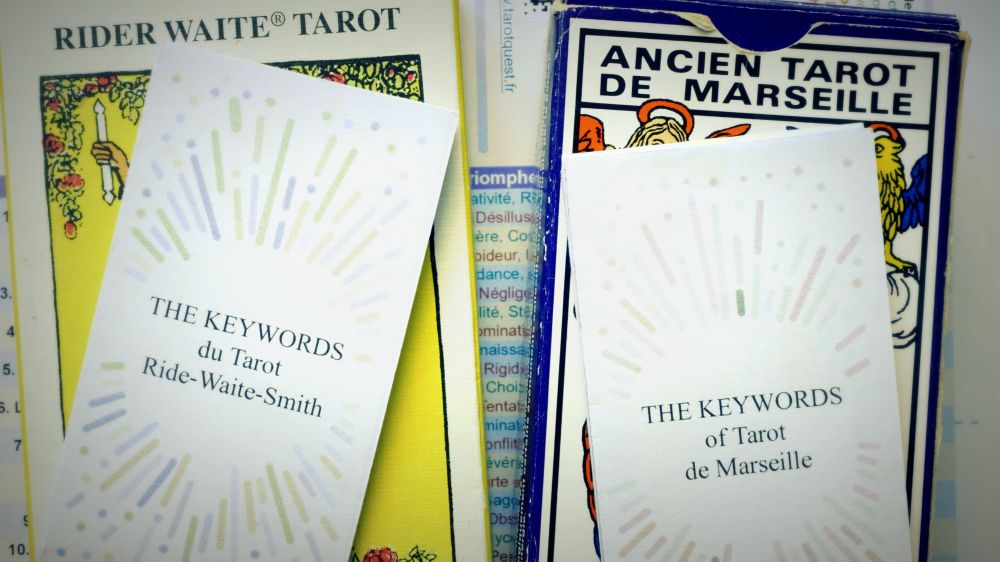
Key words for the 78 cards for the Tarot of Marseille and the Rider-Waite-Smith, to slip into your favorite deck. Your leaflets always with you, at hand, to guide you in your readings. Thanks to them, your interpretations gain in richness and subtlety.
Many people do not like this card, just as they usually avoid cards seen as negative in the Tarot of Marseille. The Moon (XVIII) is often put together with the Hanged Man (XII) or the Devil (XV) among the "difficult" cards you’d rather not see in a reading. This reaction shows our natural habit of avoiding discomfort and uncertainty—exactly what the Moon asks us to face.
Yet, as I often remind my querents: no card is really negative, and none is totally positive either. This truth is especially true for the Moon, whose darkness hides a promise of rebirth that we can only find if we first agree to go into its mysterious waters.
To really understand the Moon’s special role, we need to see it in the order of the Trumps that come before it. This sequence forms a real map of the soul’s spiritual growth.
With the Tower (XVI) coming after the Devil (XV): we see how lost we are and how our big ego has hurt our relationships with others. This moment is the height of our confusion, when we tried to control others but lost our true self. The most troubling thing is that this alienation usually happens without us knowing—when we are under the Devil’s influence, we do not realize it.
This unawareness ends suddenly with the Tower (XVI), when the truth comes: we see how lost we have been and how we lost our identity. This card stands for the needed collapse of the false ego structures, a painful destruction that lets us rebuild in a more real way.
The Star (XVII) marks the start of rebuilding: we find the path of virtue again. More than just going back to morals, this step is a deep rediscovery of our ability to love without expecting anything in return—we really learn what love is by giving without asking for something back. In this card, the woman pouring water from her jars is actually creating the lake we see in the Moon card. You could also say she "breaks the waters," and the crayfish in the lake could stand for the embryo in the amniotic fluid, like I used this image to talk about the man in the Hanged Man card, hanging by the umbilical cord in the mother’s womb.
In my personal view of the tarot, I see a flowing link between the Star and the Moon that goes beyond classic meanings. The tears poured from the Star’s jars have ended up creating a lake. This image says that our pain and vulnerability, far from being weaknesses to hide, become the very place of our transformation.
Where the classic meaning just sees a pond as decoration, I see a direct link to the emotional process shown by the Star. These tears now form a space for incubation and growth.
My special idea is about the crayfish in the Moon card. Instead of the classic meaning of Cancer or a symbol of primitive fears, I suggest another reading: the Star is giving birth, and what she brings into the world is in the water she poured out—it’s the crayfish.
This birth image totally changes how we see the card. The crayfish becomes our wounded inner child, who has been deeply hurt and has acted out—a child who, in fact, showed up earlier as the Devil. This link between Trumps XV to XVIII gives a clear psychological reading of the transformation process.
The main job of the Moon in my view is clear: we need to let our deeply wounded inner child come up to the surface to be purified and set free. This is a key step in psychological integration, when we stop pushing away our wounded parts and welcome them with awareness.
This stage takes a lot of courage. I suggest an approach of making peace with our shadow. The crayfish coming out of the water is not an outside threat but a part of ourselves that wants to be seen and healed.
In my view of the initiatory journey, the Moon is not just a card of trouble or illusion—it is a precious chance to get back important parts of ourselves that were pushed into the unconscious. This crayfish is really one of the main parts of our human psyche—ignoring it means losing an important side of who we are.
I invite you to see this often-feared card in a new way. Far from being "depressive" or negative, the Moon gives a sacred space to make peace with our shadow—a needed step towards full awareness and real spirituality. It’s in the soft, silver light of the Moon that our deepest wounds can finally find their way to healing.
| Symbolic interpretation | Right direction (Positive) | Seriousness, unconscious, receptivity, empathy, feelings, memories, memory, dreams, shadow, visions, perception, mediumship, esotericism, magic, initiation, femininity, fertility, cosmic mother, cycle | Reverse direction (Negative) | Mirage, illusion, uncertainty, trouble, ambiguity, self-denial, superstition, fear, sentimentality, immaturity, deception, lies, occultism, conditioning, whim, nightmare |
| Psychological interpretation | Right direction (Positive) | Sensitive, imaginative, deep, connected | Reverse direction (Negative) | Unfathomable, sneaky, disconnected, emotional, anxious, melancholic, versatile, moody |
| Advice | |
| You can dream but don't fool yourself! Go beyond appearances. Probe deeply. Receive everything you find. Accept your shadow. Make peace with yourself. Believe in yourself. Always remain attentive | |
| Thematic Interpretation | Love | Passionate love. Past loves. Feelings on edge. Relationship without dialogue | Work | Irrational but wise decision (or not). Routine work. Nebulous or unrealistic goals. Emotional ties at work. Profession in esotericism | Money | Intuitive approach. Uncertain investment. Random result | Family / Friendships | Shared empathy. Like brother and sister. Looking for a mentor. Strong traditional customs. Ties from the past. Troubled family atmosphere | Health | Fertility. Pregnancy. Illness without symptoms. Variable mood. Working through dreams. Hyper-emotionality. Mysticism. Schizophrenia |
| Divination / Prediction | Who ? | A sensitive person. A lunar personality. A fertile woman. A priestess. A medium | Where ? | The roof of a building. In the wild nature. Facing the sea. A church. A hermitage. A stone circle. At the bottom of the ocean | When ? | A feeling. A dream. A nightmare. A depression. A ritual. The full moon. The night. The menstrual cycle | How ? | By listening to oneself. By listening to others. By probing one's inner self. By making room for the irrational |
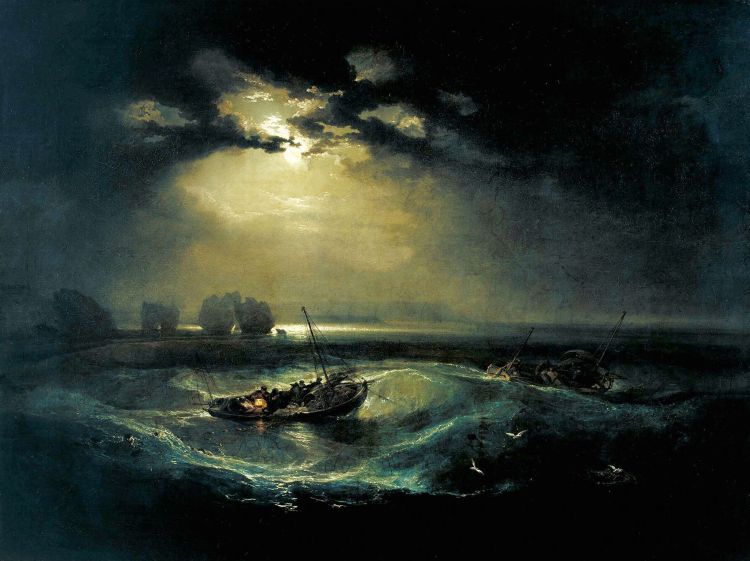
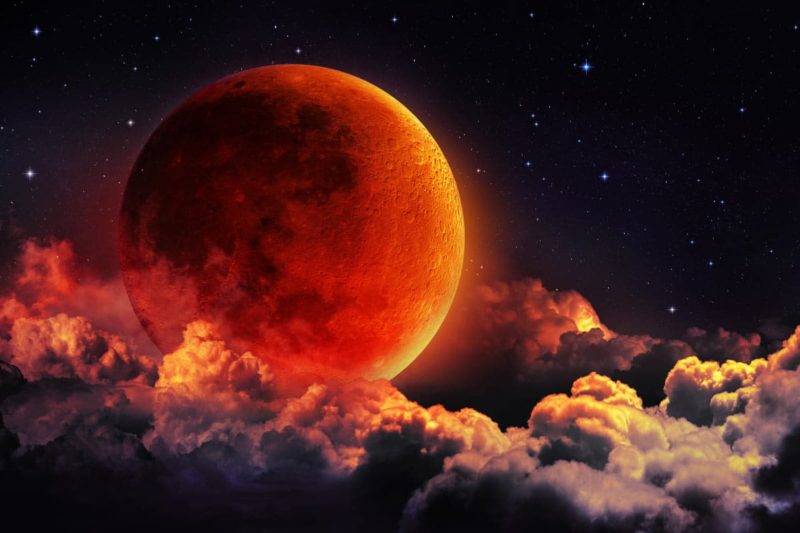
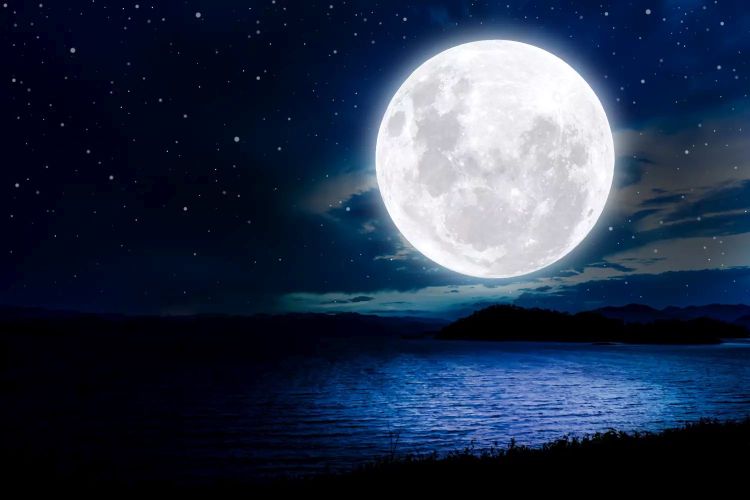
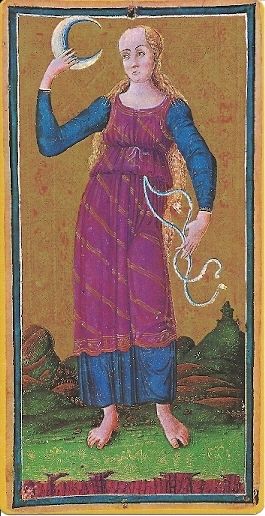
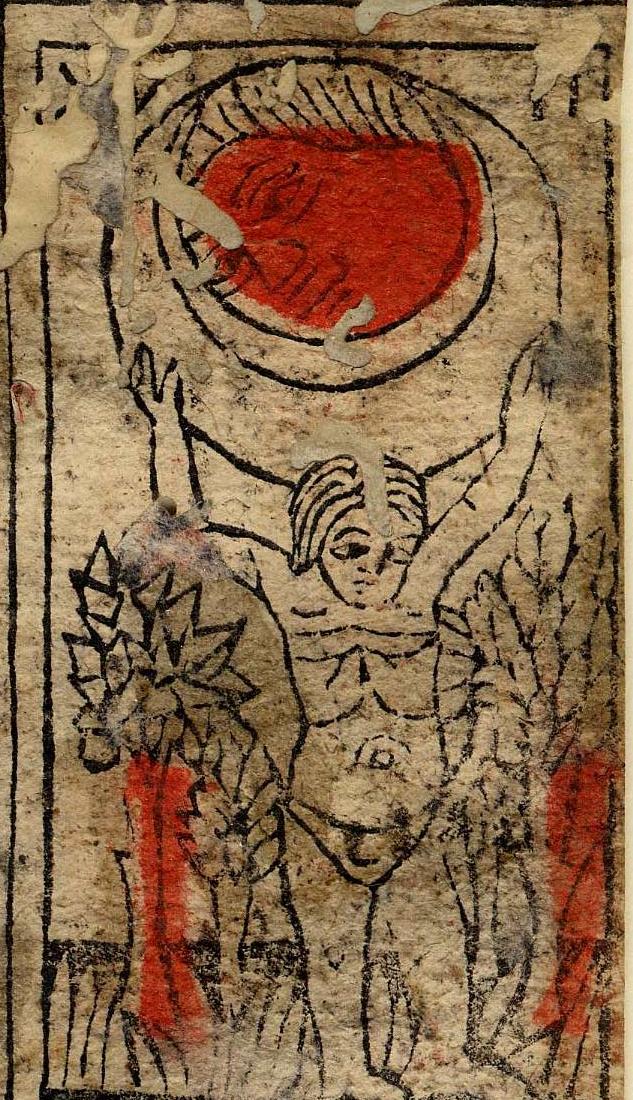
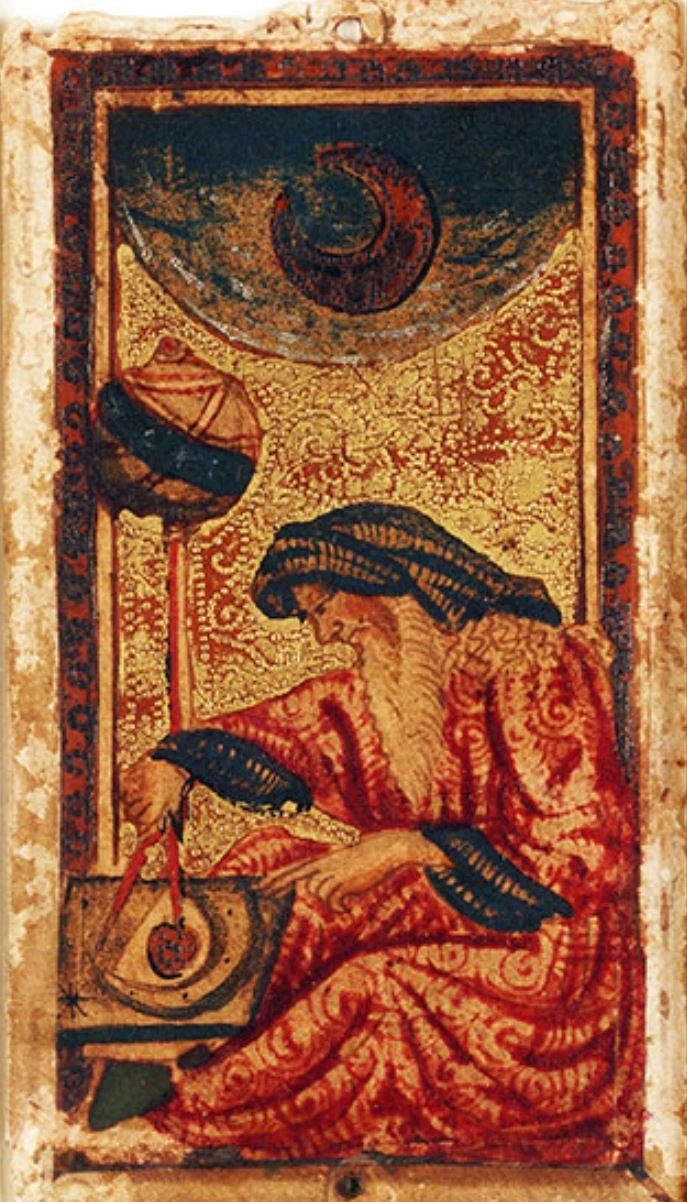
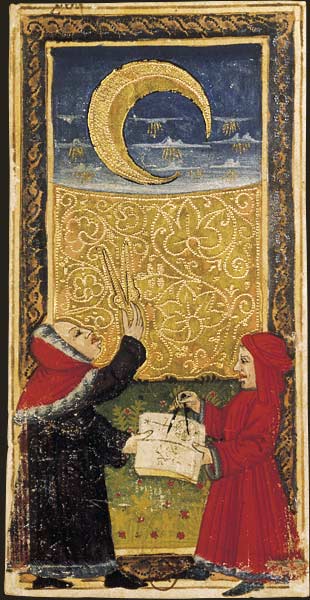
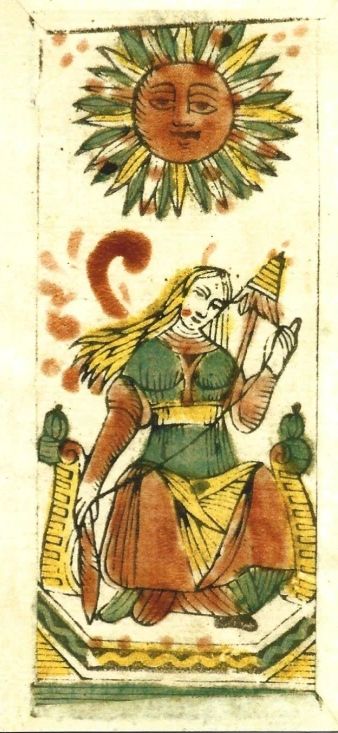
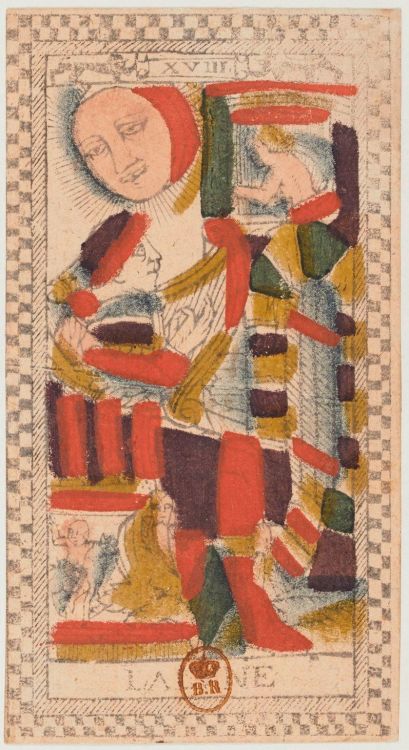
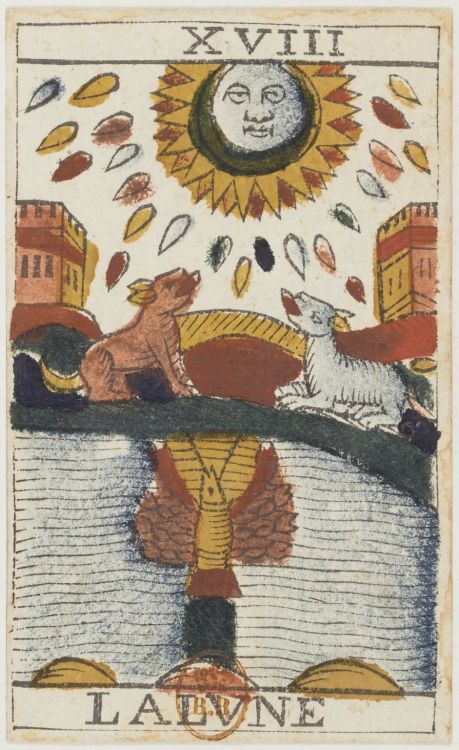
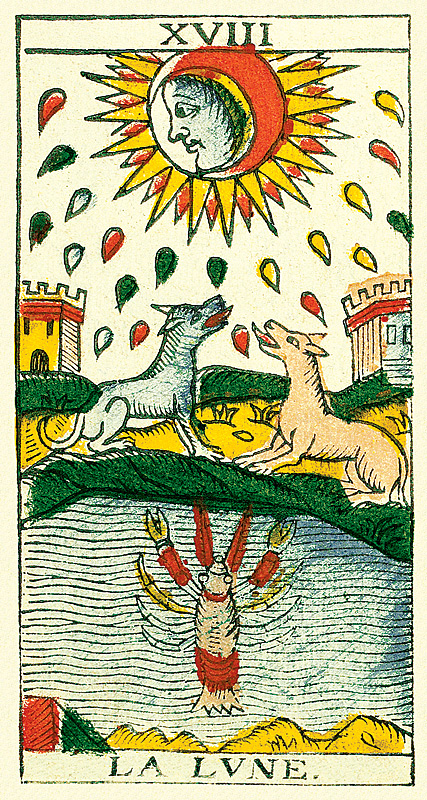
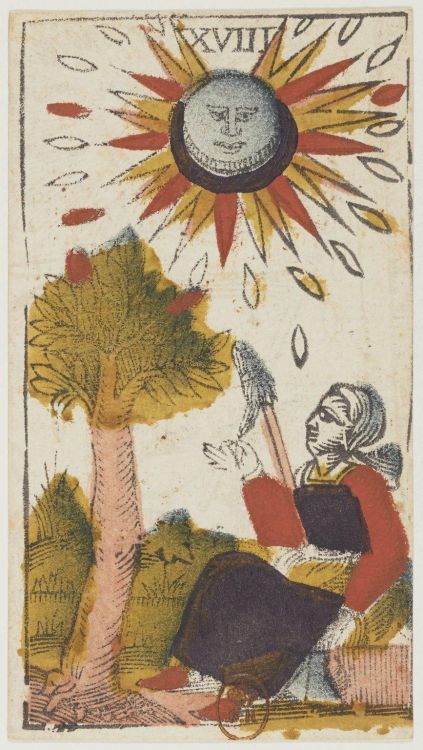
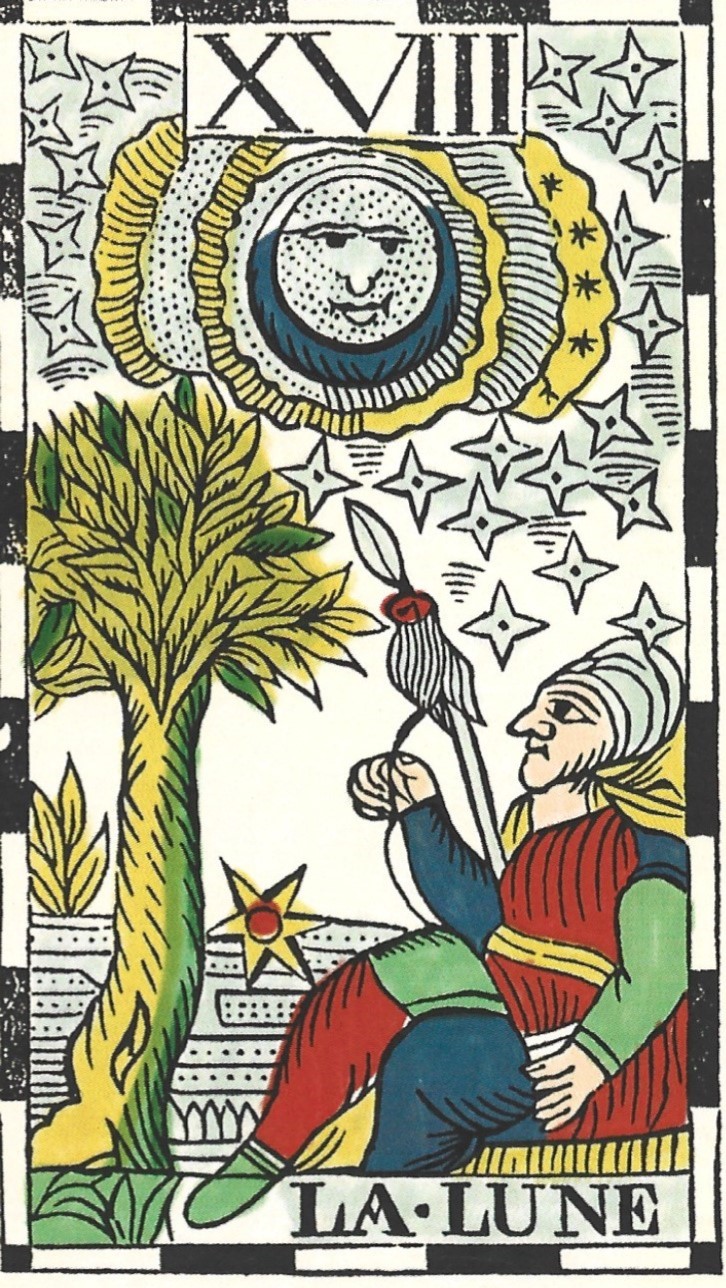
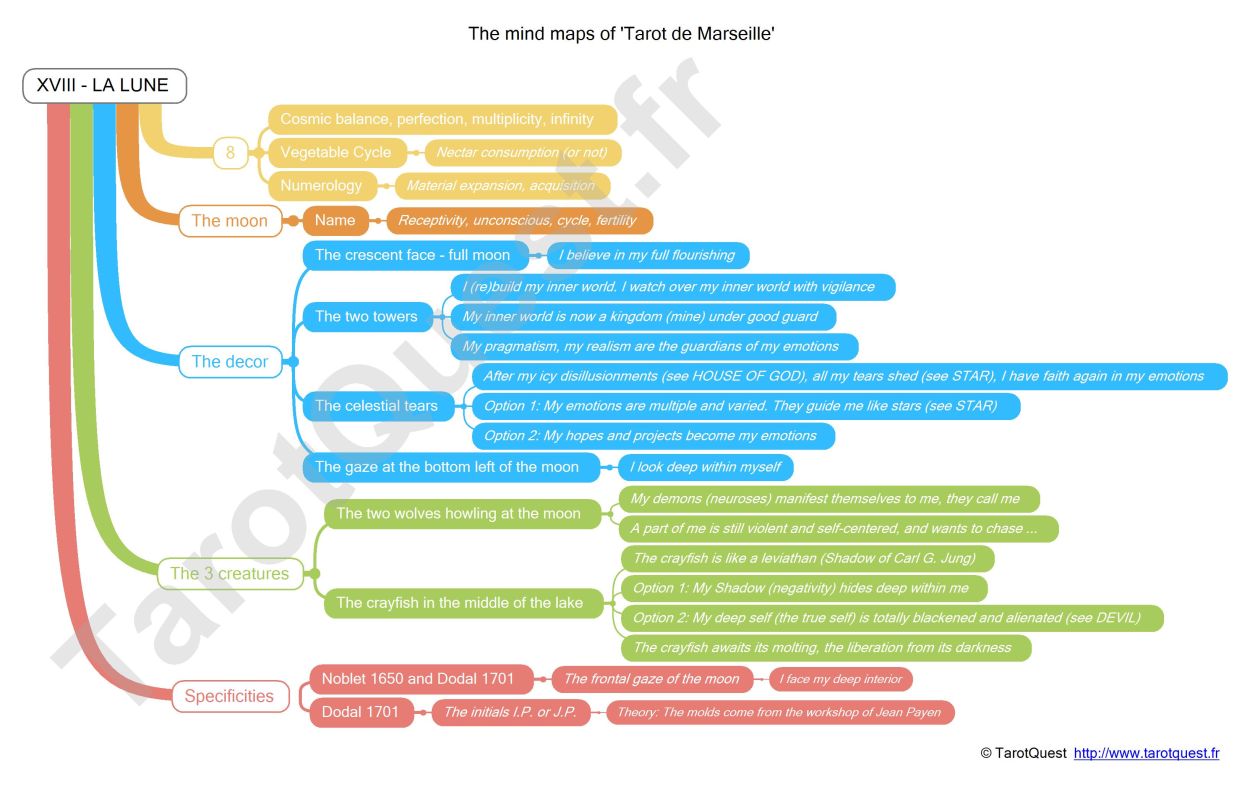
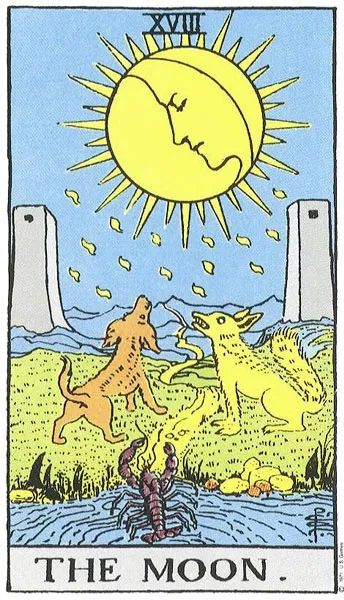
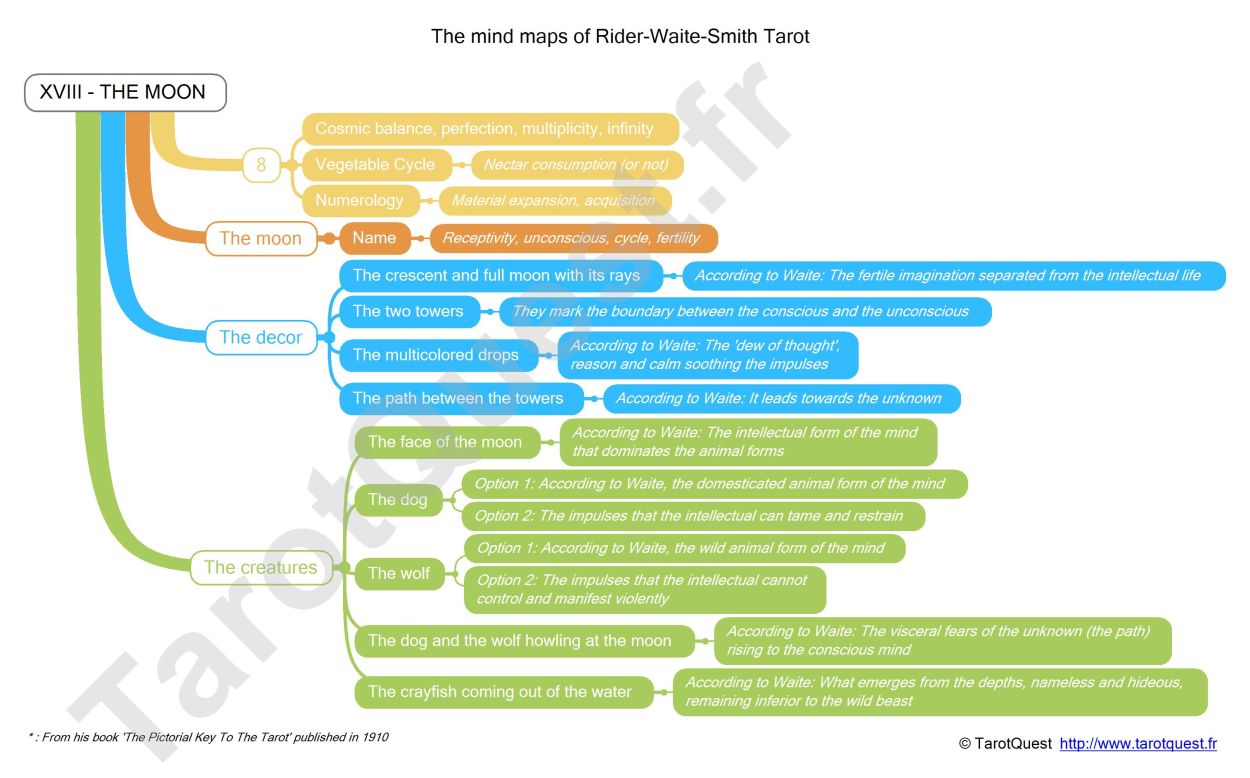
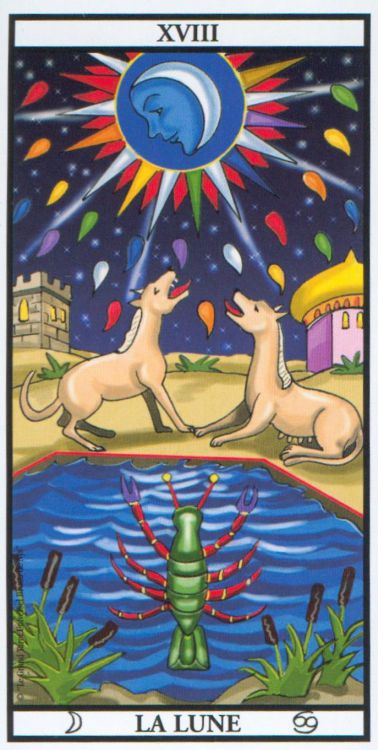
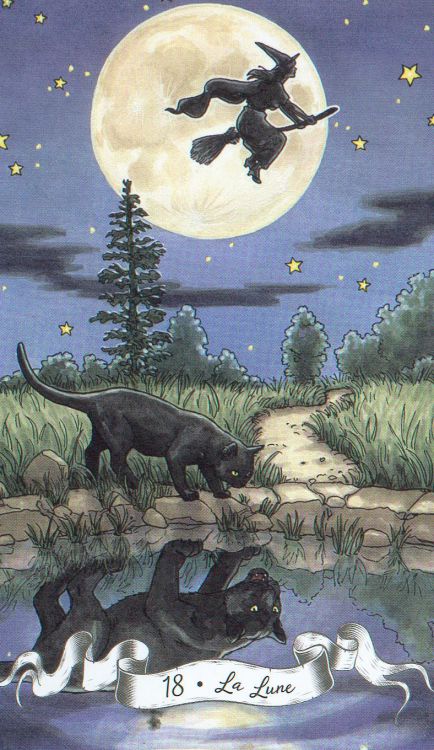
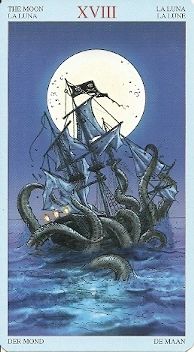
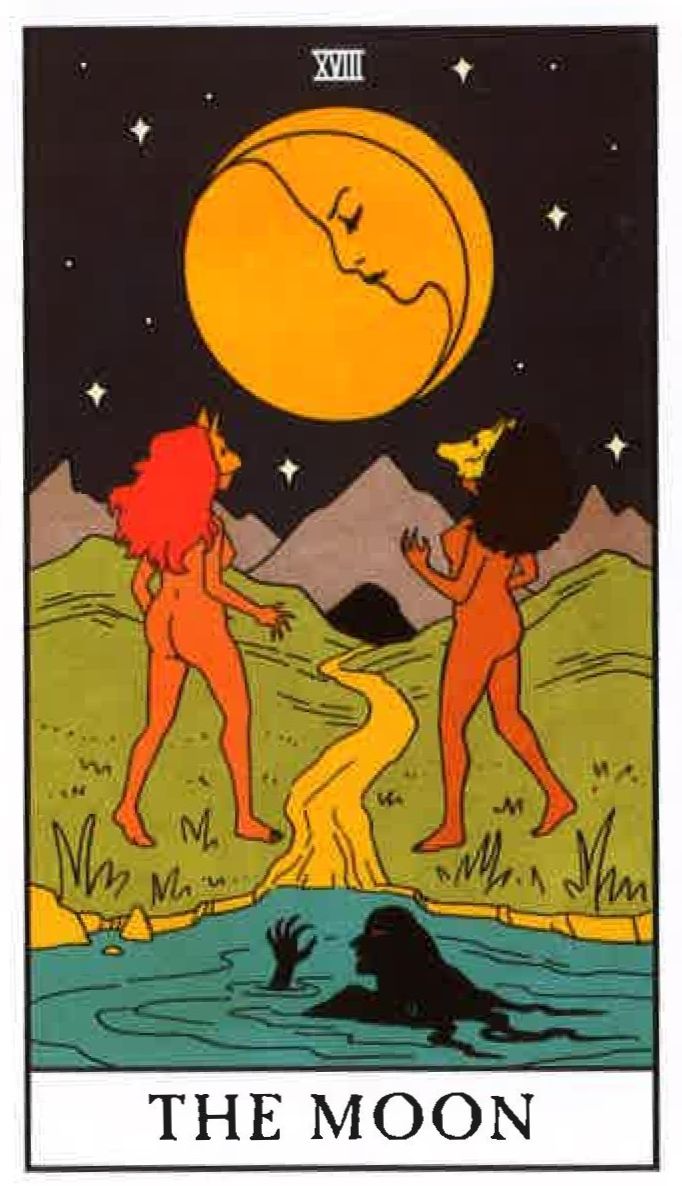
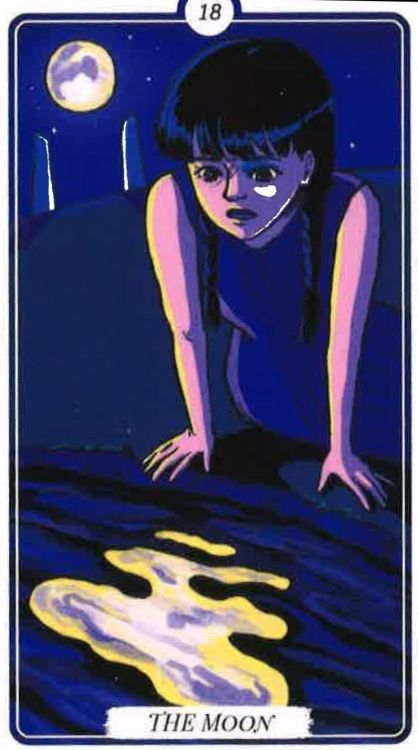
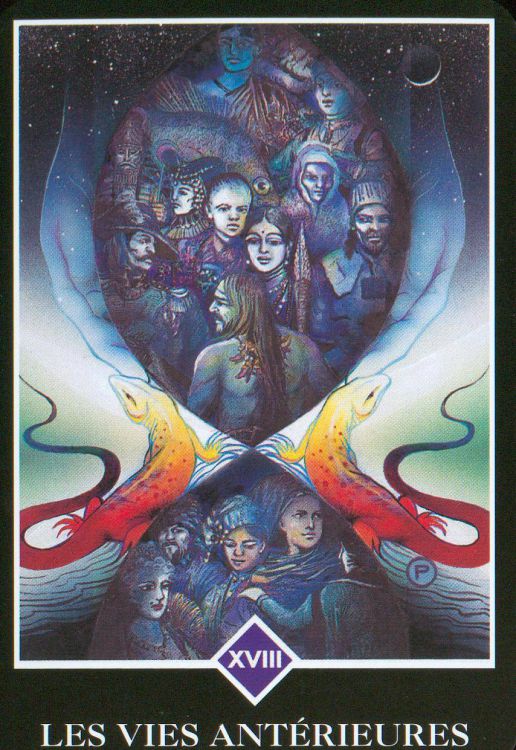
Copyright © TarotQuest.fr